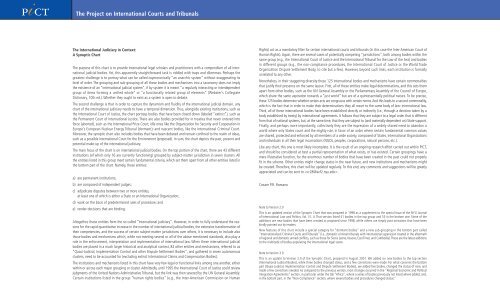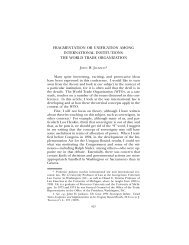chart - Project on International Courts and Tribunals
chart - Project on International Courts and Tribunals
chart - Project on International Courts and Tribunals
You also want an ePaper? Increase the reach of your titles
YUMPU automatically turns print PDFs into web optimized ePapers that Google loves.
The <str<strong>on</strong>g>Project</str<strong>on</strong>g> <strong>on</strong> Internati<strong>on</strong>al <strong>Courts</strong> <strong>and</strong> <strong>Tribunals</strong><br />
The Internati<strong>on</strong>al Judiciary in C<strong>on</strong>text:<br />
A Synoptic Chart<br />
The purpose of this <str<strong>on</strong>g>chart</str<strong>on</strong>g> is to provide internati<strong>on</strong>al legal scholars <strong>and</strong> practiti<strong>on</strong>ers with a compendium of all internati<strong>on</strong>al<br />
judicial bodies. Yet, this apparently straightforward task is riddled with traps <strong>and</strong> dilemmas. Perhaps the<br />
greatest challenge is to portray what can be called oxymor<strong>on</strong>ically “an anarchic system” without exaggerating its<br />
level of order. The grouping <strong>and</strong> sub-grouping of all these bodies <strong>and</strong> mechanisms into a tax<strong>on</strong>omy does not imply<br />
the existence of an “internati<strong>on</strong>al judicial system”, if by system it is meant “a regularly interacting or interdependent<br />
group of items forming a unified whole” or “a functi<strong>on</strong>ally related group of elements” (Webster’s Collegiate<br />
Dicti<strong>on</strong>ary, 10th ed.). Whether they ought to exist as a system is open to debate.<br />
The sec<strong>on</strong>d challenge is that in order to capture the dynamism <strong>and</strong> fluidity of the internati<strong>on</strong>al judicial domain, any<br />
<str<strong>on</strong>g>chart</str<strong>on</strong>g> of the internati<strong>on</strong>al judiciary needs to have a temporal dimensi<strong>on</strong>. Thus, al<strong>on</strong>gside existing instituti<strong>on</strong>s, such as<br />
the Internati<strong>on</strong>al Court of Justice, the <str<strong>on</strong>g>chart</str<strong>on</strong>g> portrays bodies that have been closed down (labeled “extinct”), such as<br />
the Permanent Court of Internati<strong>on</strong>al Justice. There are also bodies provided for in treaties that never entered into<br />
force (aborted), such as the Internati<strong>on</strong>al Prize Court; idle <strong>on</strong>es like the Organizati<strong>on</strong> for Security <strong>and</strong> Cooperati<strong>on</strong> in<br />
Europe’s European Nuclear Energy Tribunal (dormant); <strong>and</strong> nascent bodies, like the Internati<strong>on</strong>al Criminal Court.<br />
Moreover, the synoptic <str<strong>on</strong>g>chart</str<strong>on</strong>g> also includes bodies that have been debated <strong>and</strong> remain c<strong>on</strong>fined to the realm of ideas,<br />
such as a possible Internati<strong>on</strong>al Court for the Envir<strong>on</strong>ment (proposed). In sum, the <str<strong>on</strong>g>chart</str<strong>on</strong>g> depicts the past, present <strong>and</strong><br />
potential make-up of the internati<strong>on</strong>al judiciary.<br />
The main focus of the <str<strong>on</strong>g>chart</str<strong>on</strong>g> is <strong>on</strong> internati<strong>on</strong>al judicial bodies. On the top porti<strong>on</strong> of the <str<strong>on</strong>g>chart</str<strong>on</strong>g>, there are 43 different<br />
instituti<strong>on</strong>s (of which <strong>on</strong>ly 16 are currently functi<strong>on</strong>ing) grouped by subject-matter jurisdicti<strong>on</strong> in seven clusters. All<br />
the entities listed in this group meet certain fundamental criteria, which set them apart from all other entities listed in<br />
the bottom part of the <str<strong>on</strong>g>chart</str<strong>on</strong>g>. Namely, these entities:<br />
a) are permanent instituti<strong>on</strong>s;<br />
b) are composed of independent judges;<br />
c) adjudicate disputes between two or more entities,<br />
at least <strong>on</strong>e of which is either a State or an Internati<strong>on</strong>al Organizati<strong>on</strong>;<br />
d) work <strong>on</strong> the basis of predetermined rules of procedure; <strong>and</strong><br />
e) render decisi<strong>on</strong>s that are binding.<br />
Altogether, these entities form the so-called “internati<strong>on</strong>al judiciary”. However, in order to fully underst<strong>and</strong> the reas<strong>on</strong>s<br />
for the rapid quantitative increase in the number of internati<strong>on</strong>al judicial bodies, the extensive transformati<strong>on</strong> of<br />
their competencies, <strong>and</strong> the success of certain subject-matter jurisdicti<strong>on</strong>s over others, it is necessary to include also<br />
those bodies <strong>and</strong> mechanisms which, while not meeting several or all of the above menti<strong>on</strong>ed st<strong>and</strong>ards, also play a<br />
role in the enforcement, interpretati<strong>on</strong> <strong>and</strong> implementati<strong>on</strong> of internati<strong>on</strong>al law. When these internati<strong>on</strong>al judicial<br />
bodies are placed in a much larger historical <strong>and</strong> analytical c<strong>on</strong>text, 82 other entities <strong>and</strong> mechanisms, referred to as<br />
“Quasi-Judicial, Implementati<strong>on</strong> C<strong>on</strong>trol <strong>and</strong> other Dispute Settlement Bodies”, <strong>and</strong> gathered in seven aut<strong>on</strong>omous<br />
clusters, need to be accounted for (excluding extinct Internati<strong>on</strong>al Claims <strong>and</strong> Compensati<strong>on</strong> Bodies).<br />
The instituti<strong>on</strong>s <strong>and</strong> mechanisms listed in this <str<strong>on</strong>g>chart</str<strong>on</strong>g> have very few legal or functi<strong>on</strong>al links am<strong>on</strong>g <strong>on</strong>e another, either<br />
within or across each major grouping or cluster. Admittedly, until 1995 the Internati<strong>on</strong>al Court of Justice could review<br />
judgments of the United Nati<strong>on</strong>s Administrative Tribunal, but the link was then severed by the UN General Assembly.<br />
Certain instituti<strong>on</strong>s listed in the group “human rights bodies” (e.g., the Inter-American Commissi<strong>on</strong> <strong>on</strong> Human<br />
Rights) act as a m<strong>and</strong>atory filter for certain internati<strong>on</strong>al courts <strong>and</strong> tribunals (in this case the Inter-American Court of<br />
Human Rights). Again, there are several cases of potentially competing “jurisdicti<strong>on</strong>s”, both am<strong>on</strong>g bodies within the<br />
same group (e.g., the Internati<strong>on</strong>al Court of Justice <strong>and</strong> the Internati<strong>on</strong>al Tribunal for the Law of the Sea) <strong>and</strong> bodies<br />
in different groups (e.g., the n<strong>on</strong>-compliance procedures, the Internati<strong>on</strong>al Court of Justice or the World Trade<br />
Organizati<strong>on</strong> Dispute Settlement Body, to cite but a few). However, bey<strong>on</strong>d such links, each instituti<strong>on</strong> is formally<br />
unrelated to any other.<br />
N<strong>on</strong>etheless, in their staggering diversity these 125 internati<strong>on</strong>al bodies <strong>and</strong> mechanisms have certain comm<strong>on</strong>alties<br />
that justify their presence <strong>on</strong> the same layout. First, all of these entities make legal determinati<strong>on</strong>s, <strong>and</strong> this sets them<br />
apart from other bodies, such as the UN General Assembly or the Parliamentary Assembly of the Council of Europe,<br />
which share the same aspirati<strong>on</strong> towards a “just world” but are of a quintessentially political nature. To be precise,<br />
these 125 bodies determine whether certain acts are c<strong>on</strong>gruous with certain norms.And this leads to a sec<strong>on</strong>d comm<strong>on</strong>ality,<br />
which is the fact that in order to make their determinati<strong>on</strong>s they all resort to the same body of law: internati<strong>on</strong>al law.<br />
Third, all of these internati<strong>on</strong>al bodies have been established directly or indirectly (i.e., through a decisi<strong>on</strong> taken by a<br />
body established by treaty) by internati<strong>on</strong>al agreements. It follows that they are subject to a legal order that is different<br />
from that of nati<strong>on</strong>al systems, but, at the same time, that they are subject to (<strong>and</strong> materially dependent <strong>on</strong>) State support.<br />
Finally, <strong>and</strong> perhaps more importantly, collectively they are the expressi<strong>on</strong> of a widely shared need to ab<strong>and</strong><strong>on</strong> a<br />
world where <strong>on</strong>ly States count <strong>and</strong> the mighty rule, in favor of an order where certain fundamental comm<strong>on</strong> values<br />
are shared, protected <strong>and</strong> enforced by all members of a wide society, composed of States, Internati<strong>on</strong>al Organizati<strong>on</strong>s<br />
<strong>and</strong> individuals in all their legal incarnati<strong>on</strong>s (NGOs, peoples, corporati<strong>on</strong>s, natural pers<strong>on</strong>s, etc.).<br />
Like any <str<strong>on</strong>g>chart</str<strong>on</strong>g>, this <strong>on</strong>e is most likely incomplete. It is the result of an <strong>on</strong>going research effort carried out within PICT,<br />
<strong>and</strong> should be c<strong>on</strong>sidered at best a partial representati<strong>on</strong> of what exists, or has existed. Certain groupings have a<br />
mere illustrative functi<strong>on</strong>, for the enormous number of bodies that have been created in the past could not properly<br />
fit in the scheme. Other entries might change status in the near future, <strong>and</strong> new instituti<strong>on</strong>s <strong>and</strong> mechanisms might<br />
be created. Therefore, this <str<strong>on</strong>g>chart</str<strong>on</strong>g> will be updated regularly. To this end, any comments <strong>and</strong> suggesti<strong>on</strong>s will be greatly<br />
appreciated <strong>and</strong> can be sent to .<br />
Cesare P.R. Romano<br />
Note to Versi<strong>on</strong> 2.0<br />
This is an updated versi<strong>on</strong> of the Synoptic Chart that was prepared in 1998 as a supplement to the special issue of the NYU Journal<br />
of Internati<strong>on</strong>al Law <strong>and</strong> Politics, Vol. 31, 4. That versi<strong>on</strong> listed 41 bodies in the top group <strong>and</strong> 55 in the bottom <strong>on</strong>e. Some of the<br />
additi<strong>on</strong>s are new bodies that have been created or proposed since 1998, while others are simply past omissi<strong>on</strong>s that have been<br />
kindly pointed out by readers.<br />
New features of this <str<strong>on</strong>g>chart</str<strong>on</strong>g> include a special category for “dormant bodies” <strong>and</strong> a new sub-grouping in the bottom part called<br />
“Internati<strong>on</strong>alized Criminal <strong>Courts</strong> <strong>and</strong> <strong>Tribunals</strong>” (i.e., domestic criminal tribunals with internati<strong>on</strong>al supervisi<strong>on</strong> created in the aftermath<br />
of regi<strong>on</strong>al <strong>and</strong> domestic armed c<strong>on</strong>flicts, such as those for Sierra Le<strong>on</strong>e, Kosovo, East Timor, <strong>and</strong> Cambodia).These are the latest additi<strong>on</strong>s<br />
to the multitude of bodies populating the internati<strong>on</strong>al legal scene.<br />
Note to Versi<strong>on</strong> 3.0<br />
This is an update to Versi<strong>on</strong> 2.0 of the Synoptic Chart, prepared in August 2001. We added six new bodies to the top secti<strong>on</strong><br />
(Internati<strong>on</strong>al Judicial Bodies), while three bodies changed status, <strong>and</strong> a few correcti<strong>on</strong>s were made. For what c<strong>on</strong>cerns the bottom<br />
part (Quasi-Judicial, Implementati<strong>on</strong> C<strong>on</strong>trol <strong>and</strong> Dispute Settlement Bodies), we added five bodies, changed the status of nine, <strong>and</strong><br />
made a few correcti<strong>on</strong>s needed. As compared to the previous versi<strong>on</strong>, most changes occurred in the ”Regi<strong>on</strong>al Ec<strong>on</strong>omic <strong>and</strong> Political<br />
Integrati<strong>on</strong> Agreements” secti<strong>on</strong>, in particular under the tab “Africa”, where a series of bodies previously not listed where added, <strong>and</strong>,<br />
in the bottom part, in the “N<strong>on</strong>-Compliance” secti<strong>on</strong>, where several bodies <strong>and</strong> procedures changed status.”






